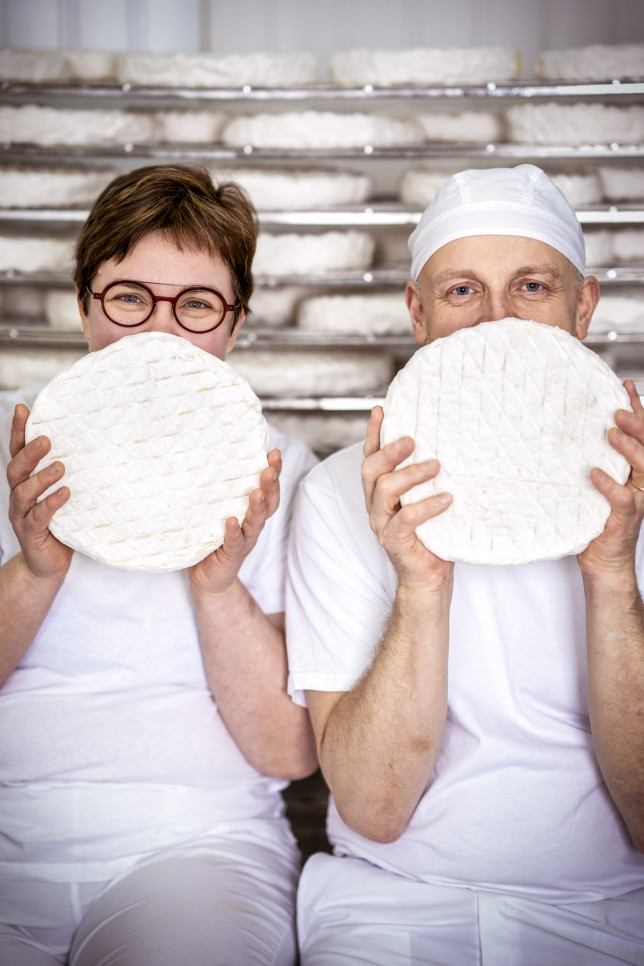The Kolatun Juustola cheesemakers – ‘Cheese is good for anything in the world.’
The story of the Kolatun Juustola cheesemakers started in 1995, when Janne Tolvi and Outi Kolattu-Tolvi decided to take in the first goats on Outi’s family farm. The cheesemaking facilities were complete in August 1996, and the cheese production was started immediately after kidding. All cheeses are still made as handiwork, without compromising in time, work, or the quality of best Finnish milk.
During the 20 years of operation, Kolattu first gave up having its own goats and began to acquire the milk from nearby farms. In the mid-2000s, the production of the first cow’s milk cheeses began, and finally, at the turn of the 2010s, the original primary means of livelihood, farming, was given up as the cheesemaking took all the time there was. Last autumn, the product range was complemented with yoghurts.
‘We started our operations with traditional goat’s cheese, and soon added feta or salad cheese. The manufacture of the mature Valdemar goat’s cheddar was started already in autumn 1997,’ Outi and Janne say about the long history of Kolattu.
They wanted to learn cheesemaking through the goat’s cheese traditional to Satakunta, but quickly wanted to include other products, as well. While Kolattu was beginning its cheese production, the MTT Agrifood Research Finland operating nearby was experimenting with the production of traditional English cheddar. The cooperation between the two led to the creation of goat’s cheddar, which has been one of the most popular Kolattu cheeses ever since, and is constantly increasing its popularity in Finland.
Problems of a small cheesemaking company and the best raw materials
Distribution continues to be the biggest problem for a small cheese company. The distribution costs are high, and even when you get your cheeses to all of the largest stores, the amounts ordered continue to be so small that the stores run out all too often. Janne throws a suggestion to shopkeepers:
‘People who buy products from small producers often do so due to a conscious decision. Therefore, it would be easier if all cheese products from small cheesemaking companies were found in one shelf, rather than scattered around the shop.’
Outi still feels that raw materials are the most significant detail in making cheese. The best raw material makes the best product. Kolattu is familiar with every dairy farm from which milk is brought for cheese, and pasteurising is the only procedure done to the milk before it becomes cheese. You will therefore not find any additives or preservatives at Kolattu.
The cheeses made with love were acknowledged in the restaurant world right away, and the best form of acknowledgement is when the best chefs in the country begin to use the products.
‘Palace was the first to use our cheese already in the 90s, when Markus Maulavirta took them there,’ Janne says, smiling.
‘It’s amazing how much cheese a person can eat’
Last year, Kolattu also began making yoghurt, when the business operations of Ahon Jogurtti Oy were moved to the control of Kolatun Juustola. While cheesemaking is started early in the morning in order to be able to lift it to mature in the afternoon, yoghurt is made the previous evening and packed first thing in the morning. Making both on the same day only required minor changes at Kolattu.
The Aho yoghurts are made using the same milk of the best quality which is also used for Kolattu cheeses. In addition, Meritalo jams of Finnish berries are used.
‘Our range includes the familiar Aho flavours: Finnish berries from sea buckthorn to cloudberry, strawberry, and raspberry, as well as natural yoghurt, vanilla and rhubarb,’ Outi says.
‘All yoghurts are made using whole milk, which gives the yoghurt a velvety texture. Only Finnish berries are used for the jams, with no artificial sweeteners.’
As is only natural, the people at Kolattu eat yoghurt for snacks, no matter what time of day it is. However, 23 years of cheesemaking has proven that if your product is just right, you will love it even after years of making it.
‘Cheese is good for anything in the world,’ Janne says with a big laugh.
”And it’s amazing how much cheese a person can eat by itself,” Outi adds.
See the recipes for Kolattu cheeses:
More information:



